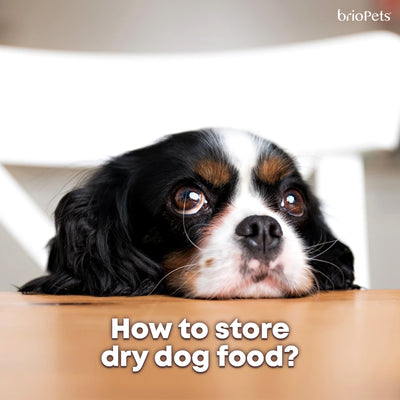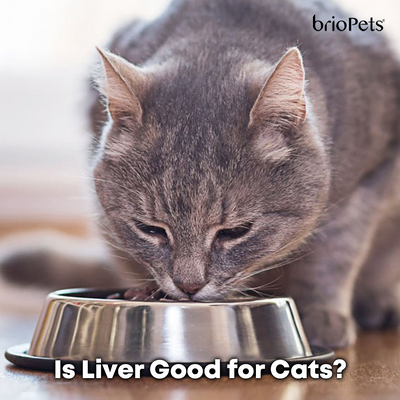
Dogs can experience allergic reactions due to a variety of causes. These can include dirt, pollen, dust, and mold. However, like humans, dogs can also have allergic reactions to specific ingredients in their food. About 10% of all allergy cases are food allergies in dogs, although they aren't as common as environmental allergies.
Usually, dogs with food allergies can be given a limited-ingredient diet or an elimination (exclusion) diet, and hypoallergenic dog food to eliminate their symptoms. In this article, we explore the cause of food allergies, the symptoms of an allergic reaction to food, the most common allergens, and what hypoallergenic dog food you can feed to your dog to prevent allergic reactions.
What is a Dog Food Allergy?
Dog food allergies result from your pet's immune system misidentifying proteins or complex carbohydrates as an invader in the body. This causes an immune response and hence food allergies.
As your dog digests protein and carbohydrates, it's broken down into smaller molecules. The immune system may start producing antibodies to various foods that it would normally tolerate, causing an allergic reaction. Food allergies in dogs can sometimes arise due to prolonged exposure to one form, type, or brand of dog food.
How Food Allergies Occur in Dogs
Similar to allergies to humans, dog allergies are developed over a period of prolonged and repeated exposure to an allergen. If a dog eats only one brand of dry food containing beef, they may suddenly experience allergies to the ingredients in that dog food. Puppies weaned too early are also susceptible to food allergies because they may not have received enough antibodies from their mothers' milk.
Symptoms of Dog Food Allergies

If your dog is itching or licking its feet, you might wonder if your dog has a food allergy. Generally, scratching non-seasonally can be a sign of allergies. For dogs, allergies usually occur in the skin. Typically a food allergy is more likely to cause itching around their face and ears. Environmental allergies may cause more feet licking and paw biting, but this doesn't always happen in all cases.
Dog food allergy symptoms can include skin infections, diarrhea, vomiting, sneezing, excessive flatulence, and itchy skin or ear inflammation. Some dogs may even have gastrointestinal and skin symptoms. However, you will need to take your dog to the vet to find out whether these symptoms are directly caused by food allergies and are not due to other causes.
Controlling Allergy Symptoms
The main way to cure allergy symptoms is to remove the allergens. However, it's important to provide some relief to your pet as they recover. Some vets may suggest baths to soothe any existing skin conditions. Bathing your pet can help to eliminate irritants living in your dog's skin and coat, soothe hot spots and itchiness, and ensure healthy skin. Topical sprays and special shampoos can also enhance comfort. Steroids, allergy shots, and antihistamines can also provide temporary relief but may not be the most natural long-term solution for allergies.
Differences Between Food Allergies and Food Intolerance
Some dogs are happy to eat just about anything. If your dog lacks a discerning palate, then it can be difficult to distinguish between a potential allergic reaction or an upset stomach.
Food allergies and food intolerance are two different things, although they are commonly mistaken for one another. Pet food allergies occur when a pet's immune system has a triggered response to a food substance like protein.
In contrast, food intolerance is an abnormal response to an ingredient that doesn't involve your pet's immune system. For example, if your dog consumes a moldy chicken from the trash, they may experience diarrhea and vomiting. This is a normal reaction to food that has turned bad or been contaminated and doesn't always involve the immune system. Instead, food intolerance mainly involves the digestive system.
Since the symptoms can be quite similar, the only way to tell the difference and determine an adverse food reaction is by performing an elimination test.
Common Dog Food Allergens

The most common allergens are animal proteins, especially from chicken, beef, pork, lamb, fish, dairy products, eggs, soy, corn, and gluten (wheat). Note that dogs can also be allergic to plant-based ingredients besides animal protein. Some dogs might also be allergic to certain preservatives or food additives.
Every time your dog consumes foods containing these substances, antibodies will react as their bodies trigger an immune system and symptoms may occur. However, the allergens that trigger symptoms varies depending on your dog. Adult dogs have a different diet compared to puppies. Active dogs may eat more proteins such as turkey, lamb, or salmon, while sedentary indoor dogs may not have them as much.
What If My Dog is Allergic to Chicken?
Chicken is used in many diets. However, some commercial dog foods may use chicken that is supplemented with steroids and high levels of antibiotics and raised unethically. They may also be loaded with a large amount of inflammatory omega-6 fatty acids.
bosch SOFT range is specially crafted for dogs with food intolerance and allergies by bosch’s in-house veterinary nutritionists with 60 years experience. bosch has dedicated farms supply meat from animals fed only with high quality and non-GMO feeds.
If your dog's diet contains a lot of home-cooked chicken and they are suffering from food allergy symptoms such as itchy skin, you may want to experiment with foods without chicken. Consider integrating other high protein sources into their dry food, such as fish, salmon, turkey, lamb, or even sweet potatoes. If the symptoms do clear up, you'll know that chicken might be the cause and to ensure your pet's diet is free of chicken.
Dog Breeds Prone To Food Allergies
Any breed of dog can suffer from food allergies. However, certain breeds tend to be more susceptible to them. These include:
- German Shepherds
- Retrievers
- Cocker Spaniels
- Dachshunds
- Dalmatians
- West Highland White Terriers
- Boxers
Treating Your Dog Food Allergy With the Elimination Diet
Although there are some blood and skin tests that can be used to determine whether your dog has a food allergy, they can vary in effectiveness and cost. An easy way to diagnose your dog for a food allergy is to feed them hypoallergenic dog food or a limited-ingredient dog food diet for about eight to twelve weeks. This is a specific method called an elimination trial. Limited-ingredient dog food contains a limited number of ingredients and typically only has a single source of carbohydrates, fats, and proteins.
An elimination diet can be done using a novel protein source, which is also called hydrolyzed protein. You may also ask your veterinarian for prescription diets with limited ingredients that are specially formulated for your dog's needs.
How It Works
First, make sure to stop feeding them any dog foods that may be causing the allergies. Have your dog start eating hypoallergenic dog food with hydrolyzed protein which are also often grain-free. Hydrolyzed animal proteins in hypoallergenic dog food have been broken down into very tiny molecules that your pet's immune system is less likely detect as allergens. Since your dog is unlikely to have tried this type of protein, it's also less likely that they may experience any allergic reactions to that type of food.
These novel proteins include duck, salmon, venison, and even other uncommon food such as quail, mini guinea fowl, trout and ostrich. bosch carries a variety of carefully formulated soft and dry dog food in these flavours, offering balanced and nutritional nourishment to dogs with allergies and sensitivities.
Since plants also have proteins, there are novel based proteins derived from plants as well. This includes bananas, millet, potatoes and sweet potatoes in their formula to round out the nutritional value.
If your dog stops experiencing symptoms, you'll know that your dog is allergic to a specific food substance. You'll then be able to slowly add ingredients to your dog's kibble to determine the specific food that causes your pet's dog food allergies. For example, you may want to add small pieces of chicken, beef, and lamb. Make sure to add one ingredient at a time so you can pinpoint exactly what your dog is allergic to. Once the symptoms return, you'll know which ingredient to not feed your dog. This process of elimination allows you to identify the allergens and formulate a limited ingredient diet centered around foods that don't cause an immune response.
Once you figure out the root cause of their food allergies, you can now buy the right hypoallergenic dog food that suits your pet's needs for a limited ingredient diet.
Cooking For Your Pet vs Purchasing Hypoallergenic Foods
Cooking raw food for your dog is a common method that many use for their limited ingredient diet plan. However, if this is not done properly, this can cause nutritional deficiencies. That's because there needs to be the proper ratio of nutrients including proteins, carbs, and fats which many pet owners may not accurately consider.
Other times, many owners forget to eliminate all other possible sources of substances causing your dog's symptoms. This also includes flavored medications. Doing the elimination test wrong will lead to inaccurate results. That's why it's essential to receive guidance from a veterinarian when you're doing an elimination diet.
What to Do After Symptoms of Allergy Stop
Just because your dog has an allergic reaction to an ingredient doesn't mean they will always be allergic to that food. Typically, allergies are caused by repeated and frequent exposures to a particular food. Rotating your dog foods and changing up their diet can sometimes strengthen your pet's digestive and immune system. It will expose your dog to a wide variety of nutrients.
After the elimination diet period, you can gradually reintroduce foods that used to cause allergies, but make sure to do it with one protein at a time. Keep in mind that your pet may experience symptoms within days or weeks, such as paw biting, dust mites, itchy skin, and loose stools. If symptoms reoccur, you can remove the allergen again.
However, if no symptoms appear, you can slowly add another protein. Keep repeating the process and use a food journal to track their reactions. You can begin to rotate new foods in your dog's diet every few weeks or months.
How Hypoallergenic Dog Foods Work in Reducing Allergies

The term hypoallergenic simply means "less" allergenic. In other words, hypoallergenic food is less likely to cause any allergic reactions in your dog. There are three hypoallergenic food types that you can experiment with.
Novel Ingredients
Novel ingredients are less available and not frequently eaten by dogs. This type of hypoallergenic food usually contains include duck, salmon, venison, and even other uncommon food such as quail, mini guinea fowl, trout and ostrich as well as grain-free carbohydrates like millet.
Limited Ingredients
A limited ingredient diet means that there are fewer than 10 ingredients. Typically, this type of hypoallergenic food contains one carbohydrate and protein source, and contains five to seven ingredients in total. One example of a limited ingredient diet is feeding your dog raw food since they typically don't have any additives, which are the primary culprits for allergies.
Limited ingredient diets are great for dogs with food allergies since you're able to use the process of elimination to identify what is triggering an immune response. However, this limited ingredient diet must be high-quality, balanced, and complete. Otherwise, it could lead to more problems.
Prescription or Veterinary Food
Prescription food contains hydrolyzed protein which has been broken down into simpler molecules such as amino acid and is less likely to cause allergies. Many commercial dry food products also have a vegetarian option designed for dogs who are extremely allergic to foods with animal protein. These proteins are usually made from hydrolyzed soy so they are free from any animal protein. However, you may need to see if your dog likes the smell and taste of the food.
Administering Hypoallergenic Dog Foods
Hypoallergenic foods can contain different ingredients that help your dog manage their food allergies. Many common protein sources can lose their effectiveness over the years. The proteins and carbohydrates in hypoallergenic dog foods are broken down into simpler substances that are less likely to trigger an immune response.
However, be careful with the hypoallergenic foods that you choose. Choose a proper hypoallergenic food that is complete and balanced, uses natural ingredients and does not include additives. A veterinarian can also recommend you hypoallergenic dog food products.
Best Dog Foods for Food Allergies

Many dog food products claim to help cure or prevent allergies in dogs, but not all of them live up to their claims. Cooking for your dog is the easiest way to ensure your dog has a limited ingredient and grain-free diet. However, if you're not confident of providing your dog a balanced diet by cooking, you can buy pet food that doesn't trigger an immune response. We've rounded up the best dog food that is designed to serve dogs with allergies.
Here are some limited ingredient diet options for dogs that bosch offers:
bosch HPC Adult Fish & Potato
Fish is an essential part of a dog's diet and can be given as a meal now and then. Ideally, foods like fish should only be fed to your dog at most one or two times per week in small amounts. Fish such as salmon contains fish oil such as omega-3 fatty acids and vitamins D and B2. These foods are rich in minerals like calcium, phosphorus, zinc, iron, magnesium, iodine, and potassium.
The bosch HPC Adult Fish & Potato contains potato flour, which is a highly digestible carbohydrate source. There are also mussel extracts that promote healthy joints and bones and reduce the risk of obesity. This meal is ideal for improving your dog's skin and coat, maintaining healthy joint cartilage, and supporting digestion.
bosch BIO Organic Adult
The bosch BIO Organic Adult food is an excellent grain-free option that uses organic herb mixes and apples for carbohydrate sources. It contains fibers that improve digestibility. Many dogs are allergic to chicken due to the unhealthy additives to make it more flavorful. The bosch BIO uses organic chicken to ensure your dog still gets a high-quality source of protein in their meal. If you're worried about the flavoring, it uses natural herbs from peas, barley, apples, pears, tomatoes, and the meaty flavor from chicken to stimulate your pet's taste buds.
bosch Adult Poultry & Millet
This bosch meal is made for dogs with normal activity levels to meet their nutritional needs. It contains 30% of fresh poultry for its protein combined with a high concentration of millet without wheat. Millet is found in high-quality hypoallergenic foods because it is easy to digest and a healthy carbohydrate source. It also contains minerals like iron, B-vitamins, and phosphorus. As a result, your dog can build healthier bones and have sustained energy.
Here are some exclusion diet options for dogs that bosch offers:
bosch SOFT Adult Chicken & Banana
A highly recommended kibble from this range is the bosch SOFT Adult Chicken & Banana, a single protein and grain-free recipe for nutritionally sensitive dogs. This specially formulated dry dog food is made with fresh chicken (60%) as the sole animal source of protein and this soft kibble with 19% moisture content offers not only high digestibility, but also spectacular taste experience, with a high acceptance rate even amongst fussy dogs.
Other than the bosch SOFT Adult Chicken & Banana, bosch also offers bosch SOFT Adult Farm Duck & Potato which is similarly, a single protein and grain-free diet for adult dogs.
bosch SOFT Mini Quail & Potato
bosch also offers nutritionally balanced kibbles for small breed dogs up to 15kg. SOFT Mini Quail & Potato contains fresh Quail (50%) as the sole animal source of protein and SOFT Mini Guinea Fowl & Sweet Potato contains fresh Guinea Fowl (50%) as the sole animal source of protein.
bosch SOFT Senior Farm Goat & Potato
bosch Senior Farm Goat & Potato is a single protein and grain-free recipe specially designed for older dogs above the age of 7. Due to the reduced fat content of the recipe, bosch SOFT Senior Farm Goat & Potato is also ideal for overweight or neutered dogs.
The Bottom Line for Hypoallergenic Dog Food
Dog food allergies can affect your dog's quality of life. But with the right hypoallergenic dog food, your dog can live a very happy and healthy life. An elimination diet can also help you to to identify the food that is triggering allergic reactions in dogs.
Fortunately, there is now a wide selection of hypoallergenic dog food options available to meet the needs of your pet. You can also consult your veterinarian to understand the best dog food options for your pets that can support the health of their digestive system.




